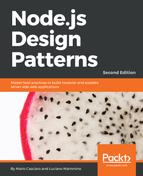- Node.js Design Patterns - Second Edition
- Node.js Design Patterns - Second Edition
- Credits
- About the Authors
- Acknowledgments
- About the Author
- Acknowledgments
- About the Reviewers
- www.PacktPub.com
- Preface
- 1. Welcome to the Node.js Platform
- 2. Node.js Essential Patterns
- 3. Asynchronous Control Flow Patterns with Callbacks
- 4. Asynchronous Control Flow Patterns with ES2015 and Beyond
- 5. Coding with Streams
- Discovering the importance of streams
- Getting started with streams
- Asynchronous control flow with streams
- Piping patterns
- Summary
- 6. Design Patterns
- 7. Wiring Modules
- 8. Universal JavaScript for Web Applications
- 9. Advanced Asynchronous Recipes
- 10. Scalability and Architectural Patterns
- An introduction to application scaling
- Cloning and load balancing
- Decomposing complex applications
- Summary
- 11. Messaging and Integration Patterns
- Fundamentals of a messaging system
- Publish/subscribe pattern
- Pipelines and task distribution patterns
- Request/reply patterns
- Summary
In this chapter, we have shed some light on Node.js streams and their use case, but at the same time this should have thrown open a door to a programming paradigm with virtually unlimited possibilities. We learned why streams are so acclaimed by the Node.js community and we mastered their basic functionality, enabling us to discover more and navigate comfortably in this new world. We analyzed some advanced patterns and started to understand how to connect streams together in different configurations, grasping the importance of interoperability which is what makes streams so versatile and powerful.
If we can't do something with one stream, we probably can do it by connecting other streams together, and this works great with the one thing per module philosophy. At this point, it should be clear that streams are not just a good to know feature of Node.js; they are, instead, an essential part of this, a crucial pattern to handle binary data, strings, and objects. It's not by chance that an entire chapter was dedicated to them.
In the next chapter, we will focus on the traditional object-oriented design patterns. But don't be fooled; even though JavaScript is to some extent an object-oriented language, in Node.js the functional or hybrid approach is often preferred. Get rid of every prejudice before reading the next chapter.
-
No Comment
